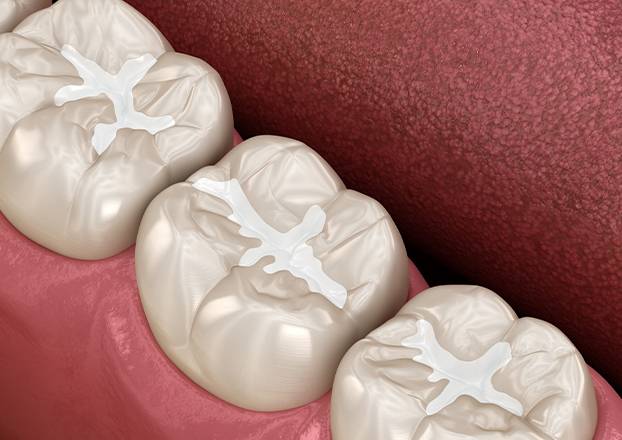Dental Sealants

Protect Your Teeth with Dental Sealants
Bacteria love to find all the nooks and crannies in teeth, especially in the back teeth used to chew. In addition to brushing and flossing, dental sealants provide another layer of protection. This thin plastic coating fills and adheres to the chewing surface of the teeth to help prevent cavities.
Dental sealants are available at Cedar Grove Dental Group in Cedar Grove and the surrounding area. Our staff can discuss the procedure and answer any questions. Call us at (973) 857-0567 to learn more and schedule an appointment.
Exploring the Advantages of a Dental Bridge
Dental sealants are a thin plastic coating that is applied to the surface of teeth to provide extra protection against tooth decay. This protective barrier helps prevent food particles from getting stuck in the grooves of the teeth and prevents bacteria and acid from causing damage. According to the American Dental Association, sealants can prevent 80% of cavities in the back teeth.
Dental sealants have been used successfully for over 40 years and are becoming increasingly popular. Research has shown that children who do not receive sealants are more than twice as likely to develop cavities compared to those who have sealants. Both the American Dental Association and the American Academy of Pediatric Dentistry recommend sealants for all children.
"Dental sealants have a proven track record of over 40 years and are increasingly popular."
Sealants: When is the Best Age to Get Them?
Sealants are beneficial for both children and adults, with the best long-term results seen when they are applied early. It is recommended that children receive sealants on their permanent molars as soon as they erupt, typically around six years old for the first molars and six years later for the second molars. This will help protect their teeth during the most cavity-prone years.
Sealants can also be beneficial for baby teeth, as they play a crucial role in maintaining the correct spacing for permanent teeth. It is important to keep baby teeth healthy and in place until they naturally fall out. When considering sealants for a younger child, ensure that they are able to keep their mouth open for an extended period and remain still during the procedure.
It is recommended that children receive sealants on their permanent molars as soon as they erupt.
The Advantages and Disadvantages
In addition to their protective properties, dental sealants have longevity and durability. Research has shown they prevent 80% of cavities for two years after application and continue to protect against 50% of cavities for up to four years. Sealants can even stay in the mouth for as long as nine years.
There are some disadvantages. Children may need to have sealants reapplied if they fall out, chip, or wear away. Dental sealants can get chipped or worn when a patient bites into hard food or eats too much food with high acidic content. It’s best to keep a close eye on what a child with sealants consumes, especially right after the sealant is applied. A patient’s bite can feel slightly off after application due to the extra layer on the tooth, but this is temporary. During a regular dental visit, we will check the sealant’s condition and reapply them as needed. Sealants need to be monitored and maintained during routine visits to ensure they do not wear away.
"Dental sealants not only provide protection, but also have long-lasting durability."
The Dental Sealant Procedure
The procedure used to apply dental sealants is quick and painless. First, the teeth are cleaned and dried. We will then apply an acidic gel to the tooth surface to help create a strong bond between the tooth and the sealant. Once the gel is rinsed off and the teeth dried again, the sealant is applied to the grooves of the chewing surface. A special curing light hardens the sealant onto the tooth.
We will also check the surface for any problems. If any issues are present, the sealant may be touched up or reapplied. Then we will rinse the newly sealed teeth clean. There are no known side effects from the procedure and no eating or drinking restrictions after treatment.
"Applying dental sealants is a fast and painless procedure"
The Experience After Sealant Application
When sealants are first applied, some children may experience slight discomfort as they adjust to having an extra layer on their back teeth. Some children may feel like their back teeth don't fit together properly at first, but the thin film will feel like a natural part of the tooth within a day or so.
Another common reaction is complaining of an unusual taste right after the sealant is applied. A quick rinse or a sip of a flavored drink can usually help get rid of the taste. Our team will be available to address any concerns or issues that may arise after the sealants are applied.




